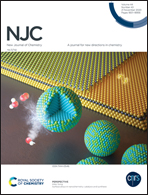Ruthenium nitrosyl complexes with the molecular framework [RuII(dmdptz)(bpy)(NO)]n+ (dmdptz: N,N-dimethyl-4,6-di(pyridin-2-yl)-1,3,5-triazin-2-amine and bpy: 2,2′-bipyridine). Electronic structure, reactivity aspects, photorelease, and scavenging of NO†
Abstract
Two mononuclear ruthenium nitrosyl complexes with a nitrogen-rich ligand coordinated molecular framework, [RuII(dmdptz)(bpy)(NO)]n+ (dmdptz: N,N-dimethyl-4,6-di(pyridin-2-yl)-1,3,5-triazin-2-amine and bpy: 2,2′-bipyridine), Enemark and Feltham notation {RuNO}6, [4]3+ (n = 3), and {RuNO}7, [4]2+ (n = 2), have been synthesized by sequential pathways from a chloro precursor [RuII(dmdptz)(bpy)(Cl)]+ [1]+via an acetonitrile complex [RuII(dmdptz)(bpy)(CH3CN)]2+ [2]2+ and a nitro complex [RuII(dmdptz)(bpy)(NO2)]+ [3]+. Single crystal X-ray structures of [1](ClO4) and [3](ClO4) have been successfully elucidated. A substantial low stretching frequency ν(NO) band of [4]3+ at 1914 cm−1 due to the influence of a pyridyl-substituted s-triazine ligand suggests the moderately electrophilic nature of NO. Density functional theory calculated trans-angles (Ru1–N6–O1) of 176.713° and 141.745° in [4]3+ and [4]2+ indicate linear and bent coordination modes of NO to central ruthenium, respectively. A noticeable shift in ν(NO) (solid) (Δν = 364 cm−1) which has been observed on moving from [4]3+ to [4]2+ is good evidence for NO-centered one-electron reduction with {RuNO}6 to {RuNO}7 bonding alteration. The redox properties of [4]3+ have been studied with precursor complexes. The electrochemical conversion of [4]3+ to [3]+ has been performed in the presence of 0.5 M NaOH solution. Both [4]3+ and [4]2+ facilitate the photocleavage of the Ru–NO bond on exposure to a xenon 200 W visible light source with first-order rate constants kNO of 8.44 × 10−3 min−1 (t1/2 = 82 min) and 4.64 × 10−2 min−1 (t1/2 = 15 min), respectively. Light-triggered release of NO has been captured by a biologically relevant target protein, reduced myoglobin, as an Mb–NO adduct.
![Graphical abstract: Ruthenium nitrosyl complexes with the molecular framework [RuII(dmdptz)(bpy)(NO)]n+ (dmdptz: N,N-dimethyl-4,6-di(pyridin-2-yl)-1,3,5-triazin-2-amine and bpy: 2,2′-bipyridine). Electronic structure, reactivity aspects, photorelease, and scavenging of NO](/en/Image/Get?imageInfo.ImageType=GA&imageInfo.ImageIdentifier.ManuscriptID=D0NJ03923C&imageInfo.ImageIdentifier.Year=2020)


 Please wait while we load your content...
Please wait while we load your content...